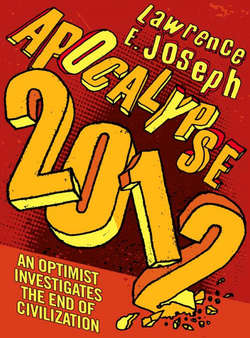Читать книгу Apocalypse 2012: An optimist investigates the end of civilization - Lawrence Joseph E. - Страница 17
TIME’S ARROWS AND CYCLES
ОглавлениеHow did these people become so time-obsessed, out in the jungles and the highlands? It’s not like the ancient Maya were catching planes or texting messages or even traveling anywhere.
“At first glance it might seem an exaggeration to attach so much importance to the sacred [Mayan] calendar. Yet anyone familiar with its role in the life of pre-Columbian Mesoamerica realizes that bound up with the calendar are many if not all of the more sophisticated aspects of the region’s early intellectual life: the awareness of a cyclicity in the movement of celestial bodies, the evolution of mathematical skills by which they could manipulate the numbers derived from those cycles, and the development of a system of hieroglyphics for recording the results … with it must have come most of the trappings of civilization—astronomy, mathematics, writing, urban planning,” writes Vincent H. Malmstrom of Dartmouth College.
We all know intuitively that time occurs in both lines, as though arrows were being shot, and cycles. Time’s arrow refers to the simple fact that each minute follows the next in a straight line to infinity, or until Time ends altogether. Time’s cycle refers to eternal continuums, such as day and night, winter, spring, summer, and fall, the waxing and waning of the Moon. Time’s cycles and arrows can also be seen as reflecting different attitudes toward history: “those who ignore it are doomed to repeat it” (cycle) versus “yesterday’s news” (arrow). I’d always tended toward the latter camp, that history, though it made for good stories, was past. But after separating from my wife at roughly the same age, and with more or less the same height, weight, and features as my father did when he was separated from my mother, the “doomed to repeat it” scenario did ring a bell.
Cultures tend to have predilections for either arrow or cycle. Contemporary postindustrial Western society certainly emphasizes the arrowlike onrush of time, passing faster and faster, blinking and beeping on watches, microwave ovens, cell phones, and turnstiles. An arrow-affinity speaks to a society’s orientation toward change and progress, though sometimes to the point of ignoring recurrent, eternal values. This imbalance may well have resulted from our shift away from an agriculturally based economy, which of course is finely attuned to seasonal cycles, and toward industrial and informational production, which are less dependent on such natural rhythms.
The Maya were and are a cycle society. They see cycles in everything, and they love what they see. Progress is not nearly as important in their cosmic ethos as the serenity that comes from being in harmony with the eternal movements of Nature. The downside of course is that, being fixated on eternal cycles, the Maya might not notice the day-to-day changes occurring around them, a disregard that helps explain why, as many historians have noted, classic Mayan society degenerated and collapsed abruptly, without their ever having taken heed of the warning signs. Theories range from voluntary disengagement, meaning that the Mayans simply abandoned their cities and much of their lifestyle for (occult) reasons of their own, to internecine strife, to claims that the civilization never really fell so much as went underground.
The current scholarly bet is that environmental degradation did them in. Indeed, Jared Diamond’s recent book, Collapse: How Societies Choose to Fail or Succeed, depicts the ancient Maya as the case study of what societies ought not to do to the local environment. Diamond methodically presses the argument that the Mayans over-farmed, deforested, and overpopulated their land. A 2004 NASA study confirms Diamond’s condemnation. Pollen trapped in sediments taken from the area right around Tikal, dating back approximately 1,200 years, just before the Mayan civilization’s collapse, indicates that trees had almost completely disappeared, replaced by weeds.
Diamond believes that the population density of the Classic Mayan civilization reached 1,500 persons per square mile. That’s double the current density, for example, of Rwanda and Burundi, two of the most crowded and troubled nations in Africa. Warfare over scarce resources inevitably broke out, leading to a complete societal collapse—a peak population of between 5 million and 14 million in 800 CE tumbled 80 or 90 percent in less than a century.
“We have to wonder why the kings and nobles failed to recognize and solve these seemingly obvious problems undermining their society. Their attention was evidently focused on their short-term concerns of enriching themselves, waging wars, erecting monuments, competing with each other, and extracting enough food from the peasants to support these activities. Like most leaders throughout human history, the Maya kings and nobles did not heed long-term problems, insofar as they perceived them,” writes Diamond.
The Mayan fall in power, prosperity, and population is quite possibly the most drastic any civilization has ever experienced. Does this invalidate their wisdom? It certainly doesn’t recommend it, except possibly in the area of catastrophe, which historically they know better than just about anyone else.
